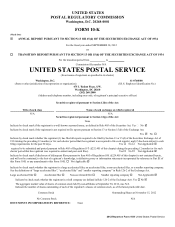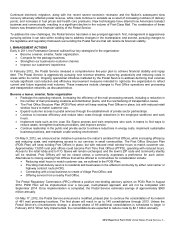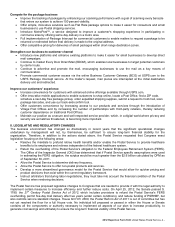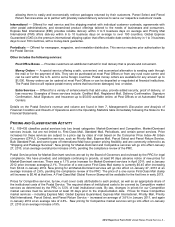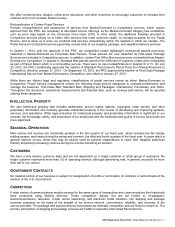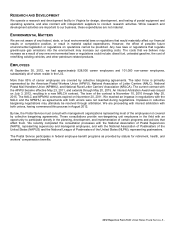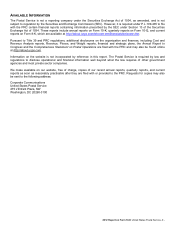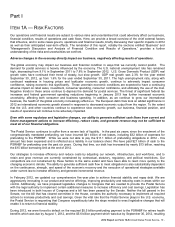US Postal Service 2012 Annual Report Download - page 3
Download and view the complete annual report
Please find page 3 of the 2012 US Postal Service annual report below. You can navigate through the pages in the report by either clicking on the pages listed below, or by using the keyword search tool below to find specific information within the annual report.
2012 Report on Form 10-K United States Postal Service- 2 -
Part I
ITEM 1 — BUSINESS
OVERVIEW
In accordance with the provisions of the Postal Reorganization Act, the United States Postal Service (we or the Postal
Service) began operations on July 1, 1971, as an “independent establishment of the executive branch of the Government
of the United States” with the mandate to offer a “fundamental service” to the American people, “at fair and reasonable
rates.” We fulfill this legal mandate to provide universal service at a fair price by offering a variety of postal services to our
many customers. Within each class of mail service, prices do not vary unreasonably by customer for the level of service
provided. The Postal Service is governed by an eleven-member Board of Governors (the Board), of which nine members
are independent Governors appointed by the President of the United States with the advice and consent of the Senate,
plus the Postmaster General, who is appointed by the independent members of the Board of Governors, and the Deputy
Postmaster General, who is appointed by the independent Governors and the Postmaster General.
The Postal Accountability and Enhancement Act, Public Law 109-435 (P.L. 109-435), made further revisions to the Postal
Reorganization Act. The Postal Service’s governing statute is codified in Title 39 of the United States Code. P.L. 109-435
also created the Postal Regulatory Commission (PRC), endowing the PRC with regulatory and oversight obligations.
We serve individual and commercial customers throughout the nation, as well as internationally; competing for business in
the communications, distribution, delivery, advertising, and retail markets. As a result, we have a very diverse customer
base and are not dependent upon a single customer or small group of customers. No single customer represents more
than 2% of operating revenue.
The law divides our services into two broad categories: Market-Dominant and Competitive “products”; however, the term
“services” is often used in this document for consistency with other descriptions of “services” offered by the Postal
Service. Price increases for those services classified as Market-Dominant are subject to a price cap based on the
Consumer Price Index — All Urban Consumers (CPI-U). The regulations for Competitive services place no upper limit on
price changes but do set a price floor. Throughout this document and in the day-to-day operation of the organization, we
refer to our major service categories as the following: First-Class Mail, Standard Mail, Shipping and Packages,
International, Periodicals, and Other. Most services in the First-Class Mail, Standard Mail, and Periodicals, are in the
Market-Dominant category. Shipping and Package Services and International Mail, which are predominantly Competitive
services, include, but are not limited to, First-Class and Standard Mail Parcels, Priority Mail, Express Mail, Parcel Select
and Parcel Return Service, Bulk Standard Post, and Bulk International Mail. On July 20, 2012, the PRC conditionally
approved the transfer of Standard Post (formerly known as Parcel Post) from Market-Dominant to Competitive.
Our services are sold through a network consisting of nearly 32,000 Post Offices, stations, and branches, plus thousands
of Contract Postal Units (CPU), Community Post Offices (CPO), Village Post Offices (VPO), retail establishments that sell
postage stamps and other services as a convenience to our customers, and our website, http://www.usps.com. Mail is
delivered six days a week to more than 152 million city, rural, Post Office box, and highway delivery points.
All references to years in this report, unless otherwise stated, refer to fiscal years beginning October 1 and ending
September 30. All references to quarters, unless otherwise stated, refer to fiscal quarters.
STRATEGY
The mission of the Postal Service is to provide secure, reliable, and affordable universal delivery service. The postal
business model for delivering trusted, affordable service to the nation worked well for many years under the Postal
Reorganization Act of 1970, which included a financial “break-even” requirement.
The enactment of P.L. 109-435 removed the “break-even” requirement and allowed the Postal Service to make a profit;
however, it imposed a number of severe economic requirements. Some of those requirements include: a unique
requirement to prefund retiree health benefits which is not required for other government organizations or private entities,
and a price cap limited to the rate of inflation on a majority of our services. These requirements are not financially
supportable by current operations. Additionally, P.L. 109-435 did not provide sufficient mechanisms to allow us to
effectively manage our labor, health care, and workers’ compensation costs.

